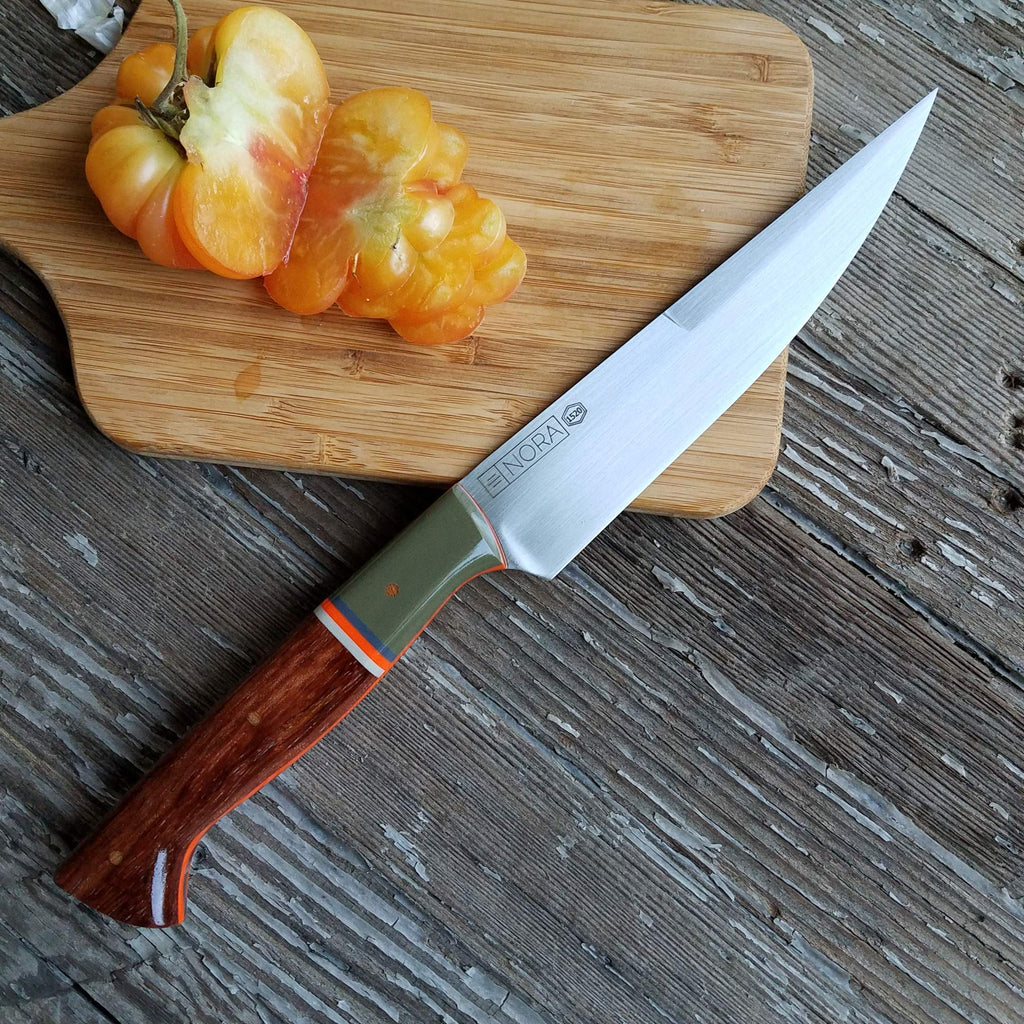
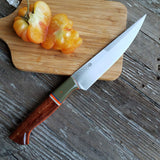


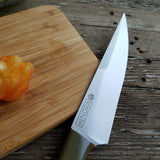
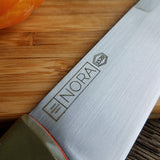

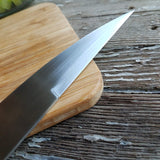


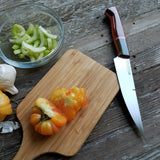
NORA #1520 - 6.5 Inch Utility - Texas Toothpick Style
$ 357.50
KNIFE HIGHLIGHTS
- Blade Type: Utility Knife
- Blade Length: 6.5 Inches
- Total Length: 11 Inches
- Handle Style: Western | Right or Left Hand Use
- Steel: AEB-L Stainless Steel
- Handle Materials: OD Green G10, Tan, Gray & Orange G10 Accents, Orange G10 Liners, Stabilized Bubinga Wood, Natural Micarta Pins
- Rockwell Hardness: 62 HRC
- Grind Type: Full Flat Hybrid - Performance Grind (3 different bevels blended) + Upper Blade Bevel near tip is not sharpened at this time
- Weight: .37 lbs.
- This Blade is Ground...
- Thin for Performance (best performance but delicate)
- Thick for Durability (tough, built to last for heavy wear-n-tear)
- >>> Mid-Range with Special Geometry (specially ground for food release and glide but blade is kept slightly thicker for durability)
- This Knife Feels...
- Heavy in Hand (Hefty. Durable.)
- Light!! (nimble, maneuverable.)
- >>> Not too heavy, not too light (Switzerland. Fitting weight for the size of the knife.)
GENERAL USES OF THIS KNIFE:
Our take on the classic utility knife. This is an extremely versatile knife that is a jack-of-all-trades worker. While a large chef knife is great, sometimes you just want a smaller, more nimble knife for some tasks. This knife is perfect for those situations. It’s a great all purpose knife that works wonderful on the line and for general food prep. While it may not tackle some of your larger food items well, it will handle roughly 80% of most kitchen tasks with ease. This design has a lot of belly worked into the blade so it’s a great little rocker if that is your preferred cutting style. We also added in a fun little bevel up top which could be sharpened if desired.
HANDLE DESIGN & MATERIALS:
Every one of our knives is handmade, numbered and unique. The number on each knife represents the production order our small company. As such, if you have NORA #1000, that knife represents the 1,000th knife made here at NORA knives.
This NORA knife has been handled with a mix of materials including stabilized African Bubinga wood, which has a beautiful reddish-brown hue, and ultra-durable G10. The main G10 used on this handle is the OD green upper. Next to this upper bolster piece there are three stripes of G10 in charcoal gray, hunter orange and tan. We love how the orange accents on this knife give just a small pop of color on this otherwise neutral design scheme.
Wood stabilization is an added feature that we offer with our knives. Wood that is stabilized has been injected with a clear acrylic resin under a vacuum process. Stabilization helps to minimize, if not eliminate, any cracking, warping, shrinkage and/or expanding of the material. Stabilized wood will not absorb water and is generally impervious to oils. The process helps to ensure your knife has a long lifespan in the kitchen.
STEEL INFORMATION:
AEB-L STAINLESS STEEL
This knife blade is composed of AEB-L stainless steel which is a high-quality Swedish metal, originally developed for razor blades. Recently, steel suppliers have made this steel available in thicker sheets and it has proven to be an excellent adaptation for the cutlery industry.
AEB-L has a beautiful balance of carbon and chromium and, with proper heat treatment, this steel produces both a very fine edge as well as excellent toughness and edge stability. The fine grain structure also makes this steel very easy to sharpen. We believe it is one of the finest stainless steels available on the market today for use with kitchen knives.
As a side note, there are two things we like to mention about this steel:
1.) This steel responds beautifully to honing and if the knife is honed regularly it should need infrequent sharpening.
2.) AEB-L is a stainless steel but just barely. The concept of stainless steel is very misleading because every steel is, at some level, reactive to water and other elements.
The higher carbon content in this stainless is what allows it to get a fine edge and higher hardness compared to many other stainless steels but it also has a tendency to sometimes form very fine rust spots on the blade. If this happens, these are easily removed with a green or red scotch brite pad and usually the rough end of a kitchen sponge will also do the trick. Take extra care to remove any excess wetness that remain on this blade. Drip drying is NOT recommended.
